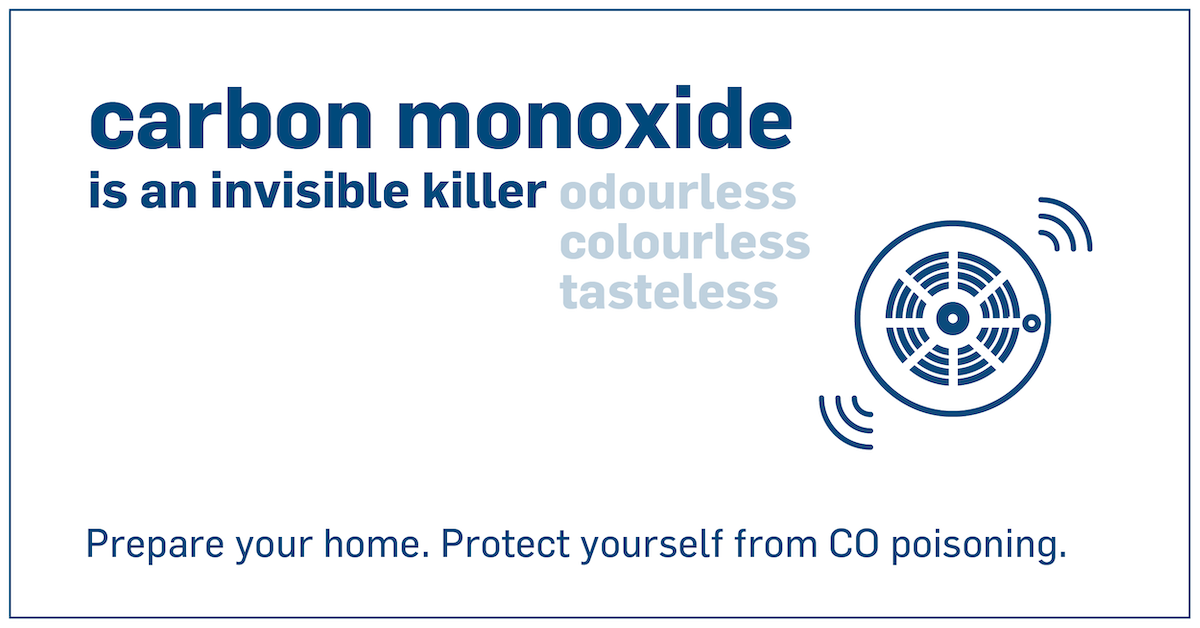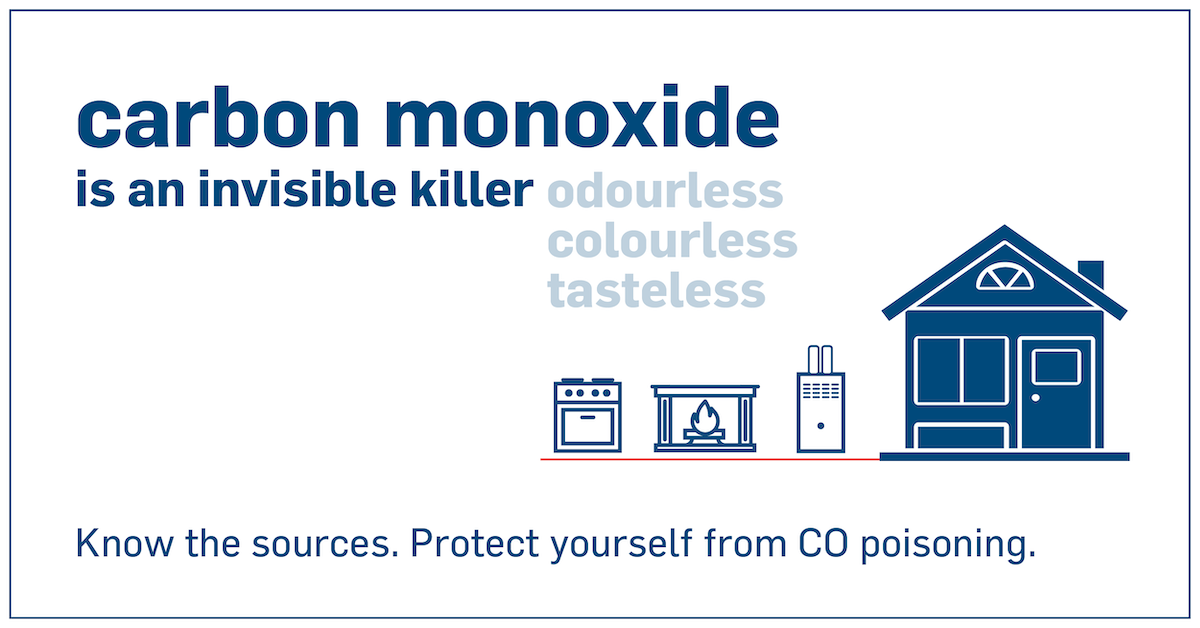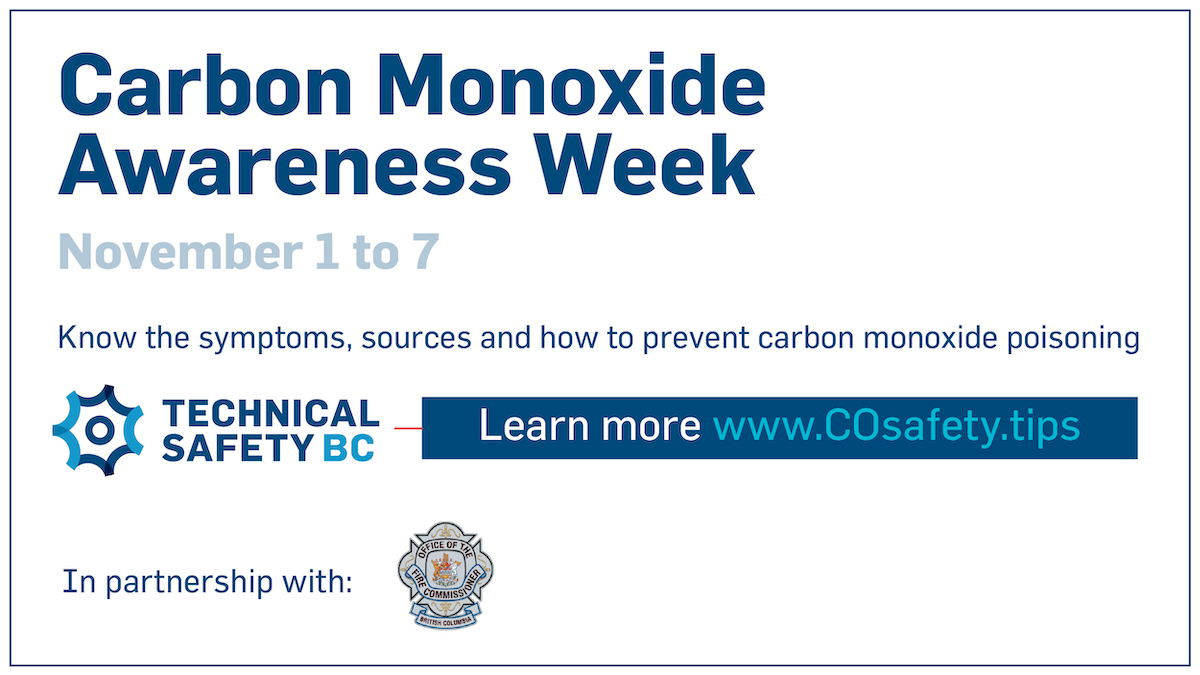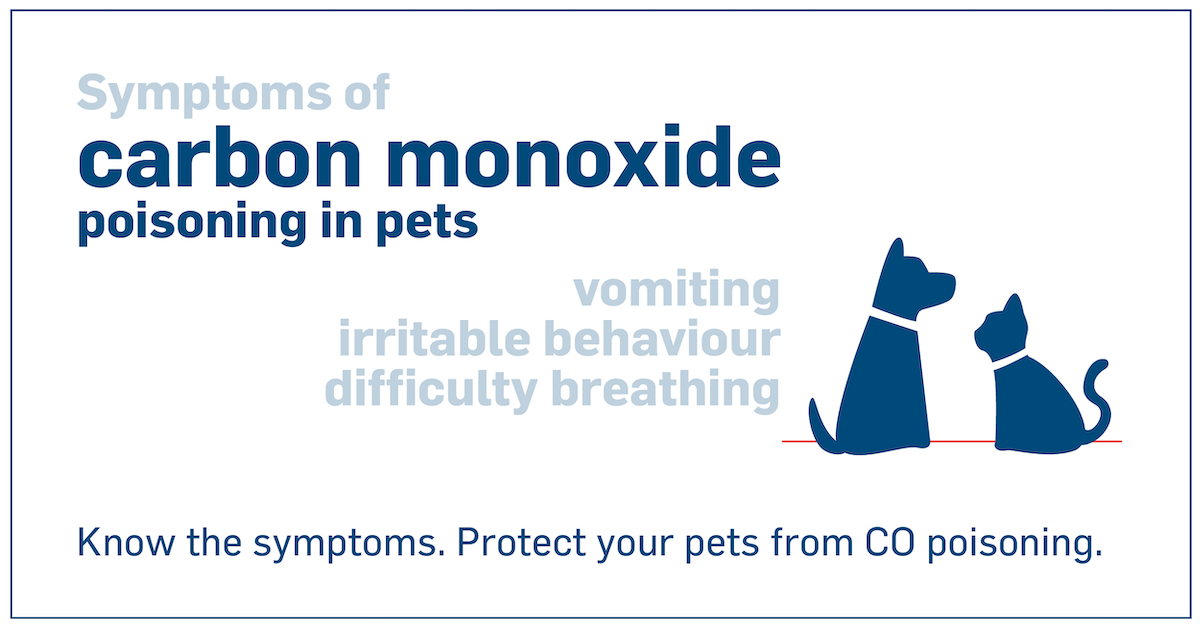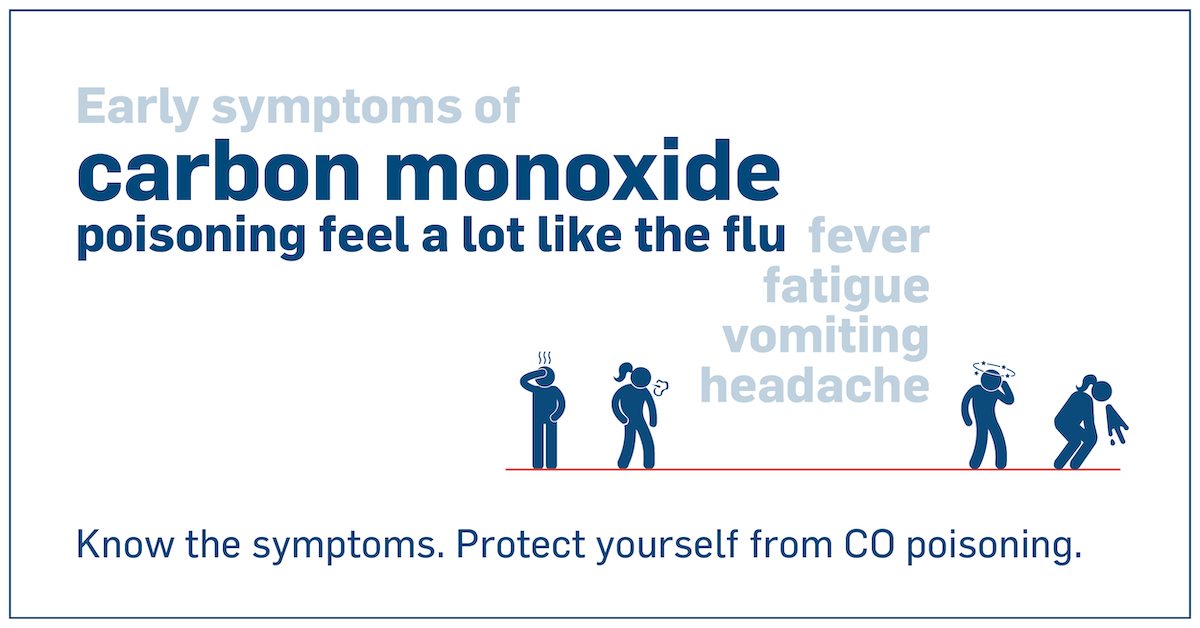Carbon monoxide awareness
Too many people in B.C. die, or become seriously ill, because of carbon monoxide (CO) poisoning. While the effects of CO poisoning can be devastating, they can be prevented. The best thing to do is have all fuel-burning appliances inspected by a licensed contractor every year. You should also install a carbon monoxide alarm that signals an alert when the gas is present.
If you have a broken or expired smoke or carbon monoxide alarm, replace it and drop your old one off for free at over 200 recycling locations in B.C. Learn more at productcare.org/alarms.
Awareness campaign resources
November 1 to 7 is Carbon Monoxide Awareness Week in B.C. During this week, fire departments, educators, government and industry work together to teach people about the dangers of carbon monoxide poisoning, the symptoms and sources, and how to avoid becoming ill.
Use the digital resources below on your social media channels or website, or conduct a door-to-door Home Safety program by visiting residents and discussing prevention tips and checking for working carbon monoxide alarms.
Home safety program and community resources
Safety brochures
Download these brochures for more information on carbon monoxide, propane and natural gas safety. Printed copies are available for free from the Fire Prevention Officers' Association online store.
Fill-in-the-blanks news release
Download the template news release and fill in the details specific to your community.
Campaign toolkit
Download the Carbon Monoxide Awareness campaign toolkit for tips and ideas on how to engage your community.
"Sorry We Missed You" door hangers
A door-to-door campaign is a great way for fire departments to get out in the community to make sure people have CO alarms in their homes. Leave a door hanger behind if the resident isn’t home. Order free printed door hangers that include CO safety and prevention tips and room for you to add your department’s contact information.
Digital resources
Sample social media posts
Copy and paste these social media posts in to your own channels as is, or customize them to meet your needs.
X (formerly Twitter)
Carbon monoxide is an invisible, odourless & deadly gas. Installing CO alarms in your home is one way to beat the silent killer; having fuel-burning appliances inspected annually is another #COsafety www.COsafety.tips
Prevent build up of carbon monoxide in your home. Have all fuel-burning appliances inspected annually & install CO alarms #COsafety www.COsafety.tips
Know the sources of carbon monoxide & how you can prevent CO build up in your home. CO is NOT natural gas. Be sure to install CO alarms! #COsafety www.COsafety.tips
Get an annual inspection of fuel-burning appliances by a registered contractor. Check for blocked vents, too #COsafety www.technicalsafetybc.ca/find-contractor @TechSafetyBC
If you live in a condo/apartment building, talk with your landlord about installing a CO alarm or install one yourself #COsafety www.COsafety.tips
Ensure outside vents for all fuel-burning appliances are clear of debris, snow and ice #COsafety www.COsafety.tips
Never use bbqs, grills or portable fuel-fired heaters/generators inside #COsafety www.COsafety.tips
CO alarms: check the manufacturer’s instructions to learn the difference between a low-battery warning sound & an emergency alarm #BeAlarmed #COsafety www.COsafety.tips
Your CO alarm sounds different than your smoke alarm. Learn how to tell them apart #COsafety www.COsafety.tips
Test CO & smoke alarms every month by pressing the test button. Replace batteries twice a year. Replace entire units according to manufacturer’s instructions #COsafety www.COsafety.tips
Replace CO alarms according to manufacturer's instructions. Test them often. #COsafety www.COsafety.tips
It’s #TestItTuesday! Now is a great time to test your CO & smoke alarms. Only working alarms will keep you & your loved ones safe #COsafety www.COsafety.tips
Only working carbon monoxide (CO) alarms save lives. If you have a broken or expired CO alarm, replace it and drop it off for free at more than 200 recycling locations across BC. Learn more at productcare.org/alarms
Do you know the symptoms of carbon monoxide poisoning? Make sure you do! It might not just be fatigue or the flu: www.COsafety.tips
When using a BBQ or grill, stay safe from carbon monoxide. Never bring them into an enclosed space (garage, tent, covered patio), even after you’ve turned them off as they can still produce dangerous fumes: www.COsafety.tips
Have you tested your carbon monoxide alarm lately? Make sure you test it to keep you, your family and your pets safe and healthy. #TestItTuesday www.COsafety.tips
Did you know that the symptoms of carbon monoxide poisoning can be mistaken for sleepiness or having the flu? Install, test and replace carbon monoxide alarms in your home so you’ll be alerted if the gas is present. www.COsafety.tips
Carbon monoxide – or CO – is known as the “silent killer” because it is an invisible, tasteless and odourless gas that can be deadly. CO is NOT natural gas – natural gas has a harmless chemical called mercaptan added to it to make it smell like rotten eggs. www.COsafety.tips
Ensure all fuel-burning appliances, chimneys and vents in your home are cleaned and inspected annually to help prevent the build up of carbon monoxide. Visit www.technicalsafetybc.ca to find a licensed contractor near you.
Prevent carbon monoxide poisoning and NEVER use BBQs or portable fuel-burning generators indoors! www.COsafety.tips
Your carbon monoxide alarm sounds different than your smoke alarm. Test BOTH alarms monthly and make sure everyone in your home knows the difference between the two sounds. #TestItTuesday www.COsafety.tips
Common questions
What is carbon monoxide?
- Carbon monoxide (CO) is a toxic gas that you can’t see or smell, which can be harmful if you are exposed to it. It's produced when fuels are burned incompletely, including natural gas, propane, wood, tobacco and gasoline.
Where does carbon monoxide come from?
Carbon monoxide (CO) is a poison gas that is a by-product of burning gasoline, natural gas, wood, oil, kerosene or propane. It can come from:
- Furnaces, gas range/stove, gas clothes dryer, water heater, portable fuel-burning space heaters, fireplaces, generators and wood-burning stoves
- Portable heaters and stoves, such as those used for camping
- Vehicles, generators and other combustion engines running in an attached garage or other enclosed space
- Blocked chimney or flue;
- Cracked or loose furnace exchanger;
- Second-hand smoke;
- Back drafting and changes in air pressure; or
- BBQs and grills.
What are the symptoms of carbon monoxide poisoning?
- Carbon monoxide (CO) is a colorless, odorless and tasteless poison gas that can be fatal when inhaled, which is why it’s sometimes called the "invisible killer". It reduces oxygenation in the body by displacing oxygen absorption at a cellular level.
- Unlike many other toxins and poisons, CO doesn’t irritate your body or cause pain—meaning there’s often no warning or danger signs of its presence.
- Initial symptoms are similar to the flu without a fever and can include dizziness, severe headaches, nausea/vomiting, sleepiness, blurred vision, fatigue/weakness, disorientation/confusion and loss of consciousness.
- CO poisoning can be particularly dangerous for people who are sleeping or intoxicated.
- People may end up with irreversible brain damage, or even die, before anyone realizes there's a problem.
How can I prevent carbon monoxide poisoning?
Proper installation
Ensure any fuel-burning appliances—and the supporting ventilation systems—are installed by a licensed contractor. Be sure to operate them according to the manufacturer's instructions.
Keep chimneys clear of animal nests, leaves and residue to ensure proper venting. Do not block or seal shut exhaust flues or ducts used by water heaters, ranges and clothes dryers.
Find a licensed contractor at www.technicalsafetybc.ca/find-contractor
Regular maintenance
Every fuel-burning heating appliance—new or old—has the potential to generate dangerous levels of CO without any obvious signs of failure.
Have all fuel-burning heating appliances cleaned and inspected annually.
Find a licensed contractor at www.technicalsafetybc.ca/find-contractor
Install CO alarms
Install at least one battery-powered carbon monoxide (CO) alarm or AC-powered unit with battery backup on each level of your home and near sleeping areas.
Test and check all CO alarms in your home twice a year. Replace CO alarms according to manufacturers’ instructions.
Other tips
Always use portable generators, BBQs, camp stoves or other similar devices away from doors, windows, vents and other openings. Never use them indoors, including inside a garage (even if the doors are open) or other enclosed or partially enclosed area.
Never use a gas range, stove or oven to heat the home.
Never leave your car idling in a closed garage. If your vehicle has an automatic engine starter, check to make sure your vehicle is turned off when it is in the garage.
Never use fuel-powered appliances or tools in enclosed, attached areas such as garages or porches.
What happens if someone is exposed to carbon monoxide?
Carbon monoxide (CO) inhibits the blood's capacity to carry oxygen and can cause health problems before you even notice that it's present.
At low levels, effects include flu-like symptoms, such as tiredness, headaches, shortness of breath and impaired motor functions.
At high levels, or if you are exposed to low levels for long periods of time, you can experience dizziness, chest pain, poor vision and difficulty thinking.
At very high levels, it can cause convulsions, coma and death.
If you suspect CO poisoning, get into fresh air immediately and call 9-1-1 or your local emergency number. Once you're at the hospital, treatment may involve:
- Breathing pure oxygen through a mask placed over your nose and mouth. This helps oxygen reach your organs and tissues. If you can't breathe on your own, a machine (ventilator) may be used.
- In many cases, hyperbaric oxygen therapy is recommended. This therapy involves breathing pure oxygen in a chamber in which the air pressure is about two to three times higher than normal. This speeds the replacement of carbon monoxide with oxygen in your blood.
Should I have a carbon monoxide alarm? Where should it be installed?
- Every home with at least one fuel-burning appliance/heater, attached garage or fireplace should have a carbon monoxide (CO) alarm
- Ideally, an alarm should be installed on every level of the home and outside each sleeping area, and placed at least 15 feet away from fuel-burning appliances. If the home has only one CO alarm, it should be installed in the main bedroom or in the hallway outside of the sleeping area
- Do not install a CO alarm near windows or vents, bathrooms, heating or fuel-burning appliances, smoke alarms (unless a combination alarm) or at the peak of a vaulted ceiling
- Make sure nothing is covering or obstructing the unit
- Test the CO alarm at least once a month by pressing the test/reset button
- Every month, unplug the unit and vacuum with a soft-brush attachment or wipe with a clean, dry cloth to remove accumulated dust
- Replace batteries and the entire unit according to manufacturer's instructions
What should I do if my carbon monoxide alarm goes off?
- If anyone is experiencing symptoms, leave your home immediately and move to fresh air. Do not try to locate the source of carbon monoxide. Once outside, call 9-1-1 or your local emergency number from a mobile phone or neighbour’s house
- If no one is experiencing symptoms, go outside and call the fire department or a licensed contractor from a mobile phone or neighbor's home to have the problem inspected
- If you are unable to leave the home to call for help, open the doors and windows and turn off all possible sources while you are waiting for assistance to arrive
- Return to your home only after the problem has been fixed by a professional
- Under no circumstance should an alarm be ignored
What else do I need to know about preventing carbon monoxide poisoning?
- Mercaptan is added to natural gas to make leaks easier to detect and smells like rotten eggs. A natural gas leak is NOT the same as accumulation of carbon monoxide
- Look for carbon monoxide (CO) alarm models with the seal of an approved certification agency such as the Canadian Gas Association or the Canadian Standards Association and the replacement date and warranty period clearly listed
- Have heating systems, vents, chimneys and/or flues inspected every year by a licensed contractor. Regularly examine vents and chimneys for improper connections, visible rust and stains
- Install and operate fuel-burning appliances according to the manufacturer's instructions
- Always use portable generators, BBQs, camp stoves or other similar devices away from doors, windows, vents and other openings. Never use them indoors, including inside a garage (even if the doors are open) or other enclosed or partially enclosed area, like a tent
- Never use a gas range, stove or oven to heat a home
- Never leave your car idling in a closed garage. If your vehicle has an automatic engine starter, check to make sure your vehicle is turned off when it is in the garage
- Never use fuel-powered appliances or tools in enclosed, attached areas, such as garages or porches

